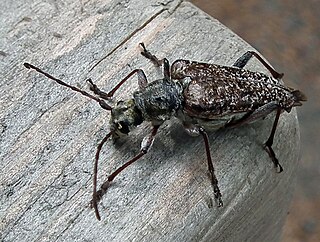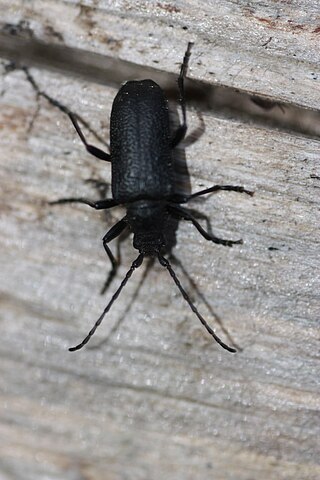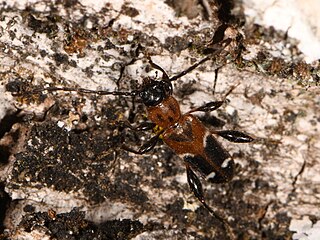
Necydalinae is a small subfamily of the longhorn beetle family (Cerambycidae), historically treated as a tribe within the subfamily Lepturinae, but recently recognized as a separate subfamily. These beetles are unusual for cerambycids, in that the elytra are quite short; they are thus rather similar in appearance to rove beetles, though most are actually bee or wasp mimics.
Anthophylax hoffmanii is a species of Long-Horned Beetle in the beetle family Cerambycidae. It is found in United States of America.
Anthophylax cyaneus is a species of Long-Horned Beetle in the beetle family Cerambycidae. It is found in Canada and United States of America.

Anthophylax attenuatus is the species of the Lepturinae subfamily in long-horned beetle family. This beetle is distributed in Canada, and USA. Adult beetle feeds on sugar maple, American beech, and on hophornbeam.
Neanthophylax pubicollis is a species of Long-Horned Beetle in the beetle family Cerambycidae. It is found in United States.
Neanthophylax subvittatus is a species of Long-Horned Beetle in the beetle family Cerambycidae. It is found in United States.

Neanthophylax tenebrosus is a species in the longhorn beetle family Cerambycidae, found in United States. The adult beetles feed on mountain hemlock and red fir.

Neandra is a genus of Long-Horned Beetles in the beetle family Cerambycidae. There are at least two described species in Neandra.

Neanthophylax is a genus in the longhorn beetle family Cerambycidae. There are at least four described species in Neanthophylax.

Atiaia is a genus of Long-Horned Beetles in the beetle family Cerambycidae. There are at least two described species in Atiaia.

Butherium is a genus of Long-Horned Beetles in the beetle family Cerambycidae. This genus has a single species, Butherium erythropus. It is found in Brazil, Ecuador, Argentina, Paraguay, and Bolivia.
Cevaeria is a genus of Long-Horned Beetles in the beetle family Cerambycidae. This genus has a single species, Cevaeria estebani. It is found in Bolivia and French Guiana.

Criodion is a genus of Long-Horned Beetles in the beetle family Cerambycidae. There are about 11 described species in Criodion.

Juiaparus is a genus of Long-Horned Beetles in the beetle family Cerambycidae. There are about five described species in Juiaparus.
Plocaederus is a genus of Long-Horned Beetles in the beetle family Cerambycidae. This genus has a single species, Plocaederus bellator. It is known from the South American countries Brazil, Ecuador, Guyana, French Guiana, Paraguay, and Suriname.

Sphallotrichus is a genus of beetles in the family Cerambycidae, containing the following species:
Aleiphaquilon is a genus of Long-Horned Beetles in the beetle family Cerambycidae. There are about nine described species in Aleiphaquilon, found in South America.

Phymatodes obliquus is a species of longhorn beetle in the family Cerambycidae. It is found Pacific coastal area of North America and Baja California.

Phymatodes varius is a species of longhorn beetle in the family Cerambycidae. It is found in North America.
Curtomerus piraiuba is a species of Long-Horned Beetle in the beetle family Cerambycidae. It is found in Colombia.










